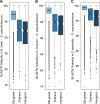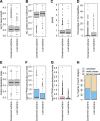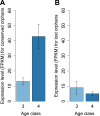The life cycle of Drosophila orphan genes
- PMID: 24554240
- PMCID: PMC3927632
- DOI: 10.7554/eLife.01311
The life cycle of Drosophila orphan genes
Abstract
Orphans are genes restricted to a single phylogenetic lineage and emerge at high rates. While this predicts an accumulation of genes, the gene number has remained remarkably constant through evolution. This paradox has not yet been resolved. Because orphan genes have been mainly analyzed over long evolutionary time scales, orphan loss has remained unexplored. Here we study the patterns of orphan turnover among close relatives in the Drosophila obscura group. We show that orphans are not only emerging at a high rate, but that they are also rapidly lost. Interestingly, recently emerged orphans are more likely to be lost than older ones. Furthermore, highly expressed orphans with a strong male-bias are more likely to be retained. Since both lost and retained orphans show similar evolutionary signatures of functional conservation, we propose that orphan loss is not driven by high rates of sequence evolution, but reflects lineage-specific functional requirements. DOI: http://dx.doi.org/10.7554/eLife.01311.001.
Keywords: D. pseudoobscura; evolutionary rates; gene gains; gene losses; pseudogenes; sex-biased expression.
Conflict of interest statement
The authors declare that no competing interests exist.
Figures






















Comment in
-
Evolution: dynamics of de novo gene emergence.Curr Biol. 2014 Mar 17;24(6):R238-40. doi: 10.1016/j.cub.2014.02.016. Curr Biol. 2014. PMID: 24650912
Similar articles
-
An evolutionary analysis of orphan genes in Drosophila.Genome Res. 2003 Oct;13(10):2213-9. doi: 10.1101/gr.1311003. Genome Res. 2003. PMID: 14525923 Free PMC article.
-
Rate of amino acid substitution is influenced by the degree and conservation of male-biased transcription over 50 myr of Drosophila evolution.Genome Biol Evol. 2012;4(3):346-59. doi: 10.1093/gbe/evs012. Epub 2012 Feb 8. Genome Biol Evol. 2012. PMID: 22321769 Free PMC article.
-
Phylogenomic analysis reveals dynamic evolutionary history of the Drosophila heterochromatin protein 1 (HP1) gene family.PLoS Genet. 2012;8(6):e1002729. doi: 10.1371/journal.pgen.1002729. Epub 2012 Jun 21. PLoS Genet. 2012. PMID: 22737079 Free PMC article.
-
Out of the testis, into the ovary: biased outcomes of gene duplication and deletion in Drosophila.Evolution. 2019 Sep;73(9):1850-1862. doi: 10.1111/evo.13820. Evolution. 2019. PMID: 31418820
-
Origin and evolution of Y chromosomes: Drosophila tales.Trends Genet. 2009 Jun;25(6):270-7. doi: 10.1016/j.tig.2009.04.002. Epub 2009 May 13. Trends Genet. 2009. PMID: 19443075 Free PMC article. Review.
Cited by
-
Evolution and implications of de novo genes in humans.Nat Ecol Evol. 2023 Jun;7(6):804-815. doi: 10.1038/s41559-023-02014-y. Epub 2023 Mar 16. Nat Ecol Evol. 2023. PMID: 36928843 Review.
-
Deep taxon sampling reveals the evolutionary dynamics of novel gene families in Pristionchus nematodes.Genome Res. 2018 Nov;28(11):1664-1674. doi: 10.1101/gr.234971.118. Epub 2018 Sep 19. Genome Res. 2018. PMID: 30232197 Free PMC article.
-
Hundreds of Out-of-Frame Remodeled Gene Families in the Escherichia coli Pangenome.Mol Biol Evol. 2022 Jan 7;39(1):msab329. doi: 10.1093/molbev/msab329. Mol Biol Evol. 2022. PMID: 34792602 Free PMC article.
-
New Genes Interacted With Recent Whole-Genome Duplicates in the Fast Stem Growth of Bamboos.Mol Biol Evol. 2021 Dec 9;38(12):5752-5768. doi: 10.1093/molbev/msab288. Mol Biol Evol. 2021. PMID: 34581782 Free PMC article.
-
Transcription Factors Drive Opposite Relationships between Gene Age and Tissue Specificity in Male and Female Drosophila Gonads.Mol Biol Evol. 2021 May 4;38(5):2104-2115. doi: 10.1093/molbev/msab011. Mol Biol Evol. 2021. PMID: 33481021 Free PMC article.
References
-
- Beckenbach AT, Wei YW, Liu H. 1993. Relationships in the Drosophila obscura species group, inferred from mitochondrial cytochrome oxidase II sequences. Molecular Biology and Evolution 10:619–634 - PubMed
Publication types
MeSH terms
Grants and funding
LinkOut - more resources
Full Text Sources
Other Literature Sources
Molecular Biology Databases

